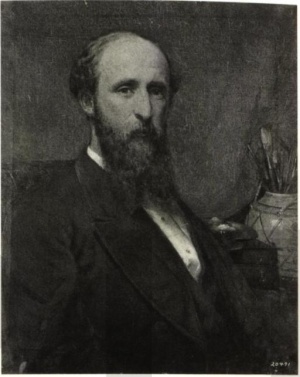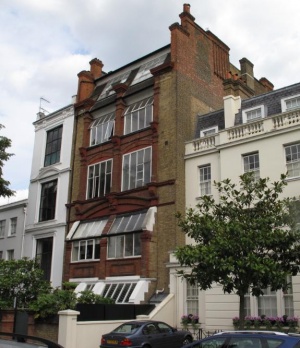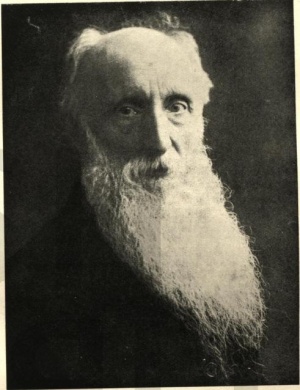William Magrath
William Magrath (1838-1918).
Irish-American watercolour painter, apparently named in the Chief Constable's Special Branch Register:[1]
- "McGrath, William - suspicious Irishman at 57 Bedford Gardens"
- "McGrath, William - said to be connected to Whitechapel murders".
Description
In 1892, his description was given as follows:[2]
Age: 54 years.
Stature: 5 feet, 8 inches Eng.
Forehead: high
Eyes: blue
Nose: prominent
Mouth: moustache
Chin: bearded
Hair: brown
Complexion: fair
Face: oval
Biography
William Magrath was born on 20 March 1838 at Cork,[2][3] and attended the Cork School of Art.[3] He emigrated to the United States in 1855, sailing from Liverpool on or about 4 July.[2][4] He appears to have lived at one time in Albany, New York State,[5] He is said to have worked initially as a sign painter in New York.[6] According to one secondary source, he had a studio in New York City as early as 1865; others say by 1868.[7] He enrolled in the National Academy's antique class in 1865-66.[8] He was a member of the American Society of Painters in Water Colors from 1868,[9], exhibited at the National Academy in 1870[10], and was elected an Associate Member in 1873[11] and an Academician in 1876.[3] By 1878 he was chairman of the Academy's Hanging Committee.[12]
His address in New York was given as 596 Broadway in 1868[13] (though he may not have resided there, as a number of organisations were listed at the same address, including the publishers of Cassell's Magazine[14]) and 35 Union Place (later Union Square) between at least 1869 and 1872.[15] In 1877 his residence was listed as 808 Broadway.[16]
Apparently he was married and widowed early in life.[17]
In 1878 it was reported that he expected to go abroad in the Autumn,[18] but two months later he had returned to East Hampton, Long Island, to sketch the beach during the September gales.[19] But in June 1879 it was reported that he was shortly to leave for England, probably to stay, which he did.[20] At the time of the 1881 census he was living in the household of Georgina Harriet Wastell at 135 Gower Street.[21] As a result of the Phoenix Park murders in May 1882, he was later said to have been "so deeply moved by what he regarded as a stain upon the fair name of his native island, that he resolved thenceforth to find other subjects for his brush," and to have abandoned his studies of Irish rural life in favour of classical subjects and landscapes, before returning to Irish themes in 1894.[22] In 1882 and 1883 his address was given as care of Charles Booth, 98 Gower Street.[23] He exhibited three works at the Cork Industrial and Fine Art Exhibition of 1883.[24] In the same year he returned to the U.S.A. and established a studio in Washington D.C.[3] He was naturalized as a citizen of the U.S.A. at Washington on 3 June 1886.[2]
Following another trip to Europe[25] he returned from Liverpool to New York on the ship Britannic, arriving on 28 October 1887.[26]
Having been commissioned to produce illustrations for a new edition of Samuel Lover's poem, "The Low-Back'd Car," he visited England and Ireland for six months in 1888.[27] Late in the year he was listed as one of a number of artists at 57 Bedford Gardens, Kensington.[28] He then sailed home from Liverpool to New York on the ship Egypt, arriving on 22 December.[29]
In 1889 he moved from Washington back to New York City,[11] but in June 1890 he again left the U.S.A., on the ship Arizona, arriving in Queenstown (now Cobh), county Cork, in July, and spending at least the next two years in England and Ireland. On 26 April 1892 he applied for a passport at the American Legation in London, describing himself as temporarily resident at 115 Gower Street, and saying that he intended to return to the U.S.A. within a year.[2] He was described as about to leave for America in November 1893.[30] He sailed on the Teutonic, departing on 6 December and arriving at New York on 15 December.[31]
In 1894 it was reported that in the Summer he intended to return to Ireland permanently.[22] He is known to have been in New York in 1895 and 1896, but in 1899 he did again travel from New York to London on the ship Marquette, arriving on 9 June.[32]
In June 1900 he was living at 11 East 14th Street, New York City, described as a house owned free of mortgage.[33] He continued to be listed at that address until 1910.[34]
In the next decade he continued to cross the Atlantic regularly. In 1902 he travelled from New York to Southampton on the ship Philadelphia, arriving on 4 June.[35] He returned from Southampton to New York on the ship Kensington, departing on 12 September 1902.[36]
According to an obituary, his great work was "The Harp that once through Tara's Hall," inspired by Thomas Moore's nationalistic lyric. This work apparently took nearly four years to complete, and was exhibited in Ireland in 1904. An Irish admirer of the artist wished to buy it, "to adorn a historic building in the event of the realisation of national aspirations" (evidently meaning Irish independence), but Magrath hesitated because he hoped it would find a home in Cork. The work is now lost.[37][6]
In 1904 he travelled from New York to Queenstown on the ship Cretic, arriving in August.[38] In 1905 he sailed back from London to New York on the ship Minneapolis, departing on 31 March and arriving on 10 April.[39]
He is said to have moved to Staten Island in 1909.[6] In April 1910 he was living at 168 Taylor Street, West New Brighton, Staten Island, New York City, the home of his brother-in-law John M. Pepper, who was apparently the husband of his sister Mary.[40] But the following month he again set sail for Ireland, travelling from New York to Queenstown on the ship Baltic and arriving on 22 May.[41] He returned from Queenstown to New York on the same ship, departing on 16 and arriving on 24 October 1910.[42] Later he is said to have moved to New Jersey, first to Towaco and then to East Orange.[6]
He is said to have moved finally to England in 1914;[6] certainly he there by 1915.[43] He died on 13 February 1918 at 19 Park Road, Harlesden, London.[44][45]
References
- ↑ Lindsay Clutterbuck, An Accident of History? The Evolution of Counter Terrorism Methodology in the Metropolitan Police from 1829 to 1901, With Particular Reference to the Influence of Extreme Irish Nationalist Activity, p. 264 (University of Portsmouth, Ph. D. Thesis, 2002).
- ↑ 2.0 2.1 2.2 2.3 2.4 Passport application, 26 April 1892 (Emergency Passport Applications (Passports Issued Abroad), 1877-1907; National Archives Microfilm Publication M1834; volume 9: Chili to Haiti, 1891-1892).
- ↑ 3.0 3.1 3.2 3.3 James Grant Wilson and John Fiske, eds, Appletons' Cyclopaedia of American Biography, vol. 4, p. 175 (1888), available at Google Books.
- ↑ According to Claudia Kinmonth, Irish rural interiors in art, p. 120 (2006), he stowed away.
- ↑ David Bernard Dearinger, Paintings and Sculpture in the Collection of the National Academy of Design: 1826-1925, vol. 1, p. 223 (2004), says that the Irish-American artist Edward Gay became part of a group of young Albany artists including Magrath, apparently in or around the late 1850s.
- ↑ 6.0 6.1 6.2 6.3 6.4 Natalie Spassky, American Paintings in the Metropolitan Museum of Art, vol. 2, p. 530 (1985).
- ↑ Allan Bowle Magruder, The Twentieth Century Biographical Dictionary of Notable Americans, vol. 7.
- ↑ Dearinger, op. cit., p. 376.
- ↑ The First One Hundred Years Membership Roster of the American Watercolor Society, on the Society's website.
- ↑ New York Herald, 11 July 1870.
- ↑ 11.0 11.1 Peter Hastings Falk, ed., Who Was Who in American Art: Artists Active Between 1898-1947, p. 391 (1985).
- ↑ New York Herald-Tribune, 2 February 1878. The report says that he "has secured for himself many of the most comfortable places, and keeps up the good old tradition by which hanging committees, since time began, have thrown delicacy to the winds and looked out unblushingly for number one."
- ↑ Trow's New York City Directory, 1868.
- ↑ Information supplied by R. J. Palmer.
- ↑ New York City Directory, 1869; 1870 Federal Census, New York, ward 18, district 1, p. 54 (addresses are not recorded, but he appears to be at 35 Union Square); Trow's New York City Directory, 1872.
- ↑ Goulding's New York City Directory, 1877.
- ↑ He was described as a widower in the 1881 U.K. census and the 1900 and 1910 U.S. censuses.
- ↑ New York Herald, 29 July 1878.
- ↑ New York Herald, 16 September 1878.
- ↑ New York Herald, 2 June 1879.
- ↑ RG 11/168, f. 8v; p 10.
- ↑ 22.0 22.1 Munsey's Magazine, vol. 11, p. 346 (July 1894).
- ↑ Claudia Kinmonth, Irish rural interiors in art, p. 149 (2006), citing Ann M. Stewart, Royal Hibernian Academy of Arts: Index of Exhibitors and Their Works, 1826-1979, vol. 2, p. 250 (1986); Institute of Painters in Water Colours, A Catalogue of the 65th Exhibition, p. 58 (1883), available at The Internet Archive.
- ↑ Cork Art History (1876-1900), on the website of The Crawford Art Gallery, Cork.
- ↑ He may have been the William Magrath who sailed from Boston, Massachusetts, to Queenstown on the Cunard Steamship Cephalonia, arriving on 17 July 1886, though as no age or occupation is recorded it is impossible to be sure (UK National Archives, BT 26/4, item 137).
- ↑ Passenger list (Microfilm roll: M237_513; line: 47; list number: 1396).
- ↑ Lippincott's Monthly Magazine, p. 25 (December 1889), available at Google Books.
- ↑ The Post Office London Directory for 1889, p. 177. Comparison of the Post Office London Directories for 1916 and 1917 shows that the houses in Bedford Gardens were renumbered at that time, and that the old number 57 became number 77. F. H. W. Sheppard, ed., The Survey of London, vol. 37, p. 80 (1973) (available at British History Online), says of this building, "Of the later houses, the most interesting is No. 77, which was built in 1882–3 by Perry and Company of Bow to the designs of R. Stark Wilkinson to contain ten studios, some with living quarters attached."
- ↑ Passenger list (Microfilm roll: M237_528; line: 47; list number: 1690).
- ↑ Cork Examiner, 24 November 1893, cited in Cork Art History (1876-1900), on the website of The Crawford Art Gallery, Cork. Magrath was exhibiting three works at the Crawford School of Art, where he had studied as a boy, and the exhibition was about to end because of his departure.
- ↑ UK National Archives, BT 27/134/8/10; Passenger List (Microfilm roll: M237_621; line: 1; page number: 14).
- ↑ UK National Archives, BT 26/146, item 7.
- ↑ US Federal Census, Manhattan Borough, supervisor's district 1, enumeration district 685, sheet 53.
- ↑ Florence N. Levy, ed., American Art Annual, vol. 6, p. 381 (1908), available at Google Books; Who's who in New York City and State, p. 890 (4th edn, 1909), available at Google Books; Albert Nelson Marquis, ed., Who's Who In America, vol. 6, 1910-1911 (1910), available at Google Books.
- ↑ UK National Archives, BT 26/204, item 15.
- ↑ UK National Archives, BT 27/391/14/8.
- ↑ Journal of the Cork Historical and Archaeological Society, new series 24, pp. 45-47 (1918).
- ↑ UK National Archives, BT 26/236, item 11.
- ↑ UK National Archives, BT 27/472/30/1; Passenger List (Microfilm roll: T715_557; line: 9; page number: 14).
- ↑ US Federal Census, roll T624_1072, page 10B, enumeration district 1301, image 1156. John Pepper had been born in England around 1833, and Mary in Ireland around 1843. Their son Robert H. Pepper had been born in New Jersey around 1880.
- ↑ UK National Archives, BT 26/430, item 4.
- ↑ UK National Archives, BT 27/683/2/18/13; Passenger List (Microfilm Roll: T715_1581; line: 20; page number: 140).
- ↑ Florence N. Levy, ed., American Art Annual, vol. 14, p. 549 (1917), available at Google Books.
- ↑ Death certificate (March quarter 1918, Willesden, 3a 314). The cause of death was "Senile Decay", and the informant was Sophia G[race] Gordon, of 19 Park Road, described as his niece. Sophia was the daughter of Isabella Agnes, who was born around 1854 in Cork, married in 1879, in Cork, the Dublin-born Francis Thomas Gordon, had at least seven children who were born in Cork, but moved to Harlesden by 1901. However, Isabella does not appear to have been a full sister of William, as her marriage does not appear in the index under the surname Magrath.
- ↑ Journal of the Cork Historical and Archaeological Society, series 2, vol. 24, pp. 45-47 (1918); Artists of the World Online database.




